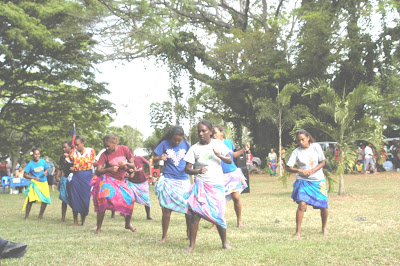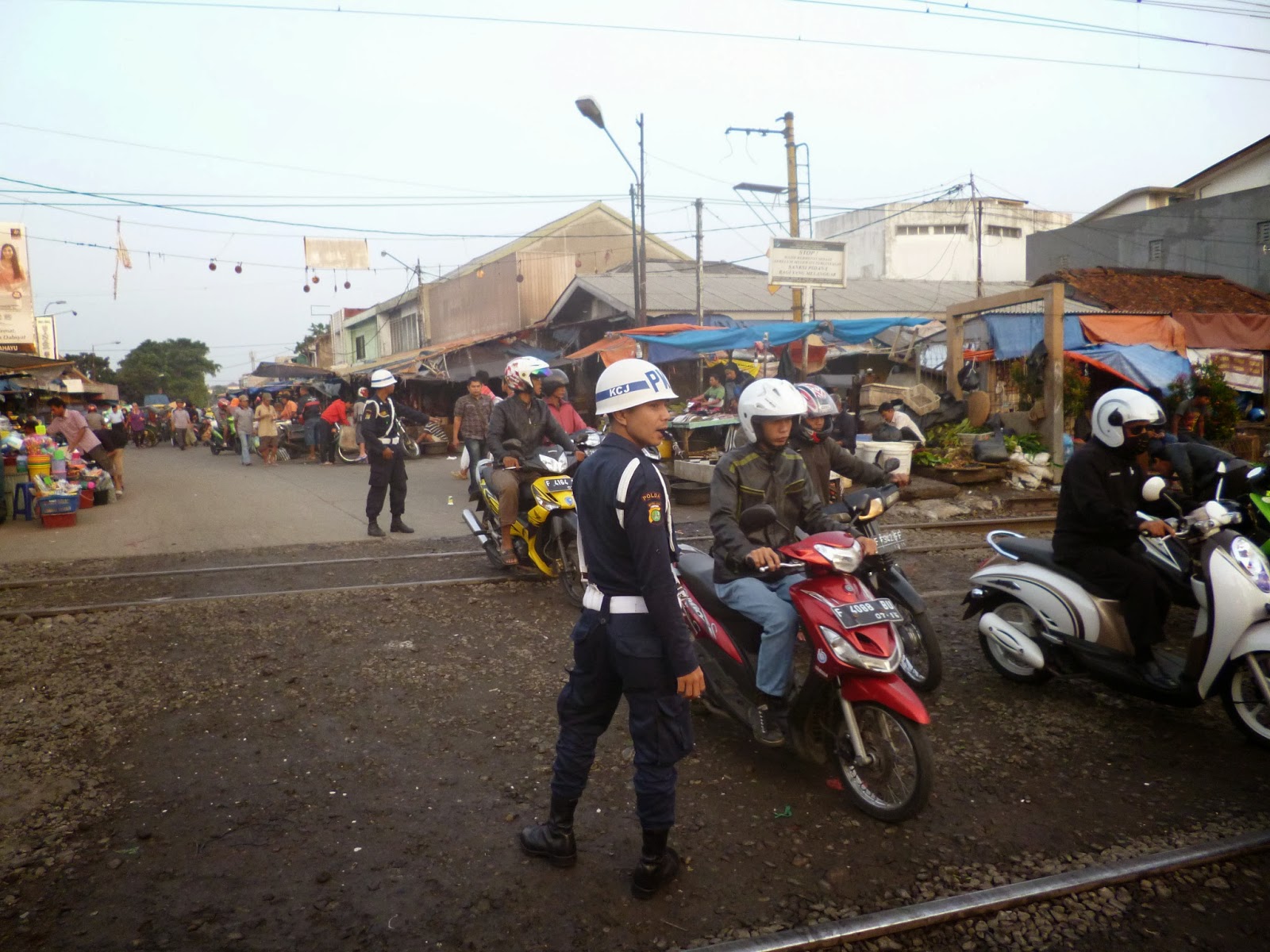Wednesday, January 8, 2014
Bogor city - Origin of the PNG oil Palm industry
Saturday, September 27, 2008
Crossing rivers and jungle

A canoe lying idle in the Akaifu River at Apainapi village
North Mekeo borders with the mountainous Goilala District and are the main mustard (eaten with betel nut and lime) suppliers in Port Moresby and Central province.
When jungle land is cleared for gardening, a section of the land is taken up by rows of the mustard plant while bananas, and kumu (greens) make up the rest, where man hasn’t stamp his mark wild pigs, wallabies and cassowaries go about their lives.
 Passengers loading up the canoe at Apainapi village for villages up the River with containers of kerozines , zoom petrol fuel and house hold items bought in Port Moresby from the sales of mustards. The opeartor (left) is collecting fares.
Passengers loading up the canoe at Apainapi village for villages up the River with containers of kerozines , zoom petrol fuel and house hold items bought in Port Moresby from the sales of mustards. The opeartor (left) is collecting fares.
As wild animals, reptiles and other ground creatures inhabit the land, Birds of Paradise, parrots, cockatoos and flying foxes soar well into the skies. Schools of various river fish, prawns, lobsters and other marine life inhabit the numerous rivers and streams that form the Akaifa River.
To take a breather from the hustle and bustle of the city life I ventured into this remote area for five days with my friend Richard Kange.

Upriver villagers waiting at Apainapi village with mustard parcels for a Port Moresby bound pasenger truck to sell .
Mr Kange who is a local from Ioi village and I got on a passenger truck in Port Moresby last week loaded with bags of rice, flour, sugar and other store goods for the 200km trip to Apanaipi village.
Containers and drums of kerosene and zoom were also piled onto the truck for the trip. The villagers had bought these items after selling their mustards in Port Moresby.
After a dusty three hour trip we arrived at Apanaipi where we then got on a loaded motorized dugout canoe and traveled for another three hours to Maipa village.
The trip up the 50 meter wide brownish river was no joke, either. A slight hitch and it will be everyone for himself.

Passengers on the motorsied canoe along the Akaifu River bound for Ioi village.
Among the passengers were women and children who we had traveled together from Port Moresby on the truck.
However, the canoe operator was an expert along these parts and avoided all the tree stumps and other obstacles that littered the River.
As it was a busy river and main route for villagers living along the banks, we past non motorized canoes loaded with garden food and people returning from their gardens situated away from the banks.
As the motorized canoe got closer to Maipa, the river flow became faster as the banks became narrower.

Young girls helping their mothers taking the dirty dishes to the river to be washed at Maipa village
About 50 meters from the village the canoe stopped and every one disembark for the walk home as the River had become shallow.
Only our cargoes remain on the canoe which was pushed along the river toward the village.
It was about 5pm when we arrived at the village, home to about 500 people.
Retrieving our bags, Richard and I walked to the Ngope (Richard’s friend) family’s house.
Although they were unprepared for us, they made us comfortable as best as they could by sharing their normal evening meal of boiled bananas, creamed rice with hot black tea.
 Elders on the village chief's platform at Maipa village
Elders on the village chief's platform at Maipa village
It was nightfall when we strolled down to the River and had our bath and return to sell under mosquito nets. The next day (2nd day) we toured the village to see the villagers’ daily activities.
The following day (3rd day) at about 9am, we walked for an hour through a muddy bush track passing food gardens and crossed two icy cold streams to Ioi village.
While relieved to see Richard, his family again was surprised to have me there as they were unprepared to have a visitor. However they made me feel at home and took me once again on a tour of their village. I also swam in one of the crystal clear creek to soak up the cool waters as I do not have that opportunity back in the city.

A child helping his father stack parcels of mustards at Maipa vilage under their house to sell in Port Moresby.
That creek is also a tributary of the main Akaifu River. That evening we had freshly smoked wild pork meat with boiled bananas and black hot tea.
The next day (4th day) also about 9am after a breakfast of boiled bananas we left Ioi village and head south for Inauwani village situated along the Angabanga River.
This was the most grueling trip for me as we once again slugged through mud for six hours. Although grueling, it was bearable as the slugging was along flat land.
 Maipa villagers in front of a classroom at their Top Up Primary school. The empty gas cylinder is the school's bell.
Maipa villagers in front of a classroom at their Top Up Primary school. The empty gas cylinder is the school's bell.
There were no villages or gardens along this track but thick jungle made up of various vines, ferns and towering trees. These tress with thick branches also blocked out strong sun light to make the walking bearable.
Along the way had to cross the Inaugavanag, Vangama, Vavaunge and the Ma’avunga Rivers along the way.
 Ioi village lass Anna Fiabia sorting out her newly harvested mustrads for sale in Port Moresby . This heap will fetch her over K800.
Ioi village lass Anna Fiabia sorting out her newly harvested mustrads for sale in Port Moresby . This heap will fetch her over K800.
These Rivers are also the tributaries to the main Akaifa River.
The Inaugavanag and Vangama proved dangerous to cross. The Inaugavanag about 30meters wide and over a meter deep was fast flowing.
 Parceling the mustards
Parceling the mustards
I almost lost my footing when crossing it (Inaugavanag) with my bag hoisted above my head and water level at my stomach (I’m 172cm tall). But directions from Richard helped me through to the other side.
On both sides of the Vangama River, Richard warned me to follow his footstep. A slight deviation will see me sink into puddles of quicksand.
 Villagers at Ioi village with loaded bags of garden food and mustard parcels on a motorised canoe ready for about a three hours trip down to Apainapi village.
Villagers at Ioi village with loaded bags of garden food and mustard parcels on a motorised canoe ready for about a three hours trip down to Apainapi village.
After an endless walk with my bag cutting into my shoulders and leg muscles aching, we arrived at another of Richard’s friend Charlie Au’Au’s house at Inauwani at around 4pm.
After a refreshing bath in the Angabanga River, I again had some boiled bananas with hot black tea and went straight to bed net due to the tiring trip.
Next day (final day) after a tour of the village, Richard and I got on a passenger truck at about 2pm and return back to Port Moresby.
 Richard wading through one of those numerous bush creek enroute to Inawani village.
Richard wading through one of those numerous bush creek enroute to Inawani village.
When entering the city limits after about three hours drive, I began to realize that I miss the North Mekeo people’s hospitality of sharing their available resources with visitor. Even at a sudden notice.
Such hospitality is rarely experienced among the city residences
.
Tuesday, September 2, 2008
The Pacific Way

And you Samoans, Tongans, Kiribatis, Solomon Islanders, Vanuatus and Fijians can identify your wantoks hotly dancing away ha ha ha.
 Kiribati students swaying to their traditional beat
Kiribati students swaying to their traditional beatThe Pacific Island students relaxed from their busy academic studies to ensure that the crowd received the similar scenario and excitement that was displayed and felt at the 10th South Pacific Festival of Arts held in Pago Pago American Samoa in July.
 The dynamic students displayed their respective unique dances and drama to depict legends of their daily traditional livelihoods before non Pacific Islanders arrived on their isolated white sandy shores and tropical rain forest islands.
The dynamic students displayed their respective unique dances and drama to depict legends of their daily traditional livelihoods before non Pacific Islanders arrived on their isolated white sandy shores and tropical rain forest islands.
Samoan students displaying their traditional dance
Their performances truly expressed their rich traditional Melanesian, Polynesian and Micronesian political, economical and social activities before the Westminster Government system superseded their traditional activities.

The displaying of their cooked traditional food also expressed their love of preparing various dishes from nutritious garden food like, sago, taro, yams, bananas, pumpkins and greens like aibika and cabbages.
 A string band by Vanuatu students performing for the girls to dance
A string band by Vanuatu students performing for the girls to danceThese tasty dishes were also prepared with land and marine proteins prefered by the Adventist church faithfulls.
 A Vanuatu traditional dish comprising of mumu chicken and taro that was quickly eaten by the hungry crowd
A Vanuatu traditional dish comprising of mumu chicken and taro that was quickly eaten by the hungry crowdApart from the dances and food, the Tongans apart from dancing also performed a moving and well expressed drama depicting how the kava and sugar cane plants originated in their island
 Vanuatu girls dancing to the beat of their boys' string bag
Vanuatu girls dancing to the beat of their boys' string bag  Southern region students of PNG performing a traditional dance from the Kiwai area in the Western Province
Southern region students of PNG performing a traditional dance from the Kiwai area in the Western Province
Island region students from PNG performing a traditional dances from the Manus Province
 The Fijian students performing their traditional dance
The Fijian students performing their traditional dance
 Solomon Island girls putting heart and soul to the beat of their traditional music
Solomon Island girls putting heart and soul to the beat of their traditional music 
 Tongan students swaying to the beat of their traditional music
Tongan students swaying to the beat of their traditional music 
Apart from displaying their cultures, the Open day was held to show the public what educational programs and facilities were offered at PAU.




















